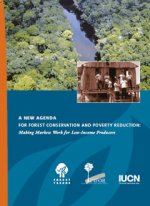A New Agenda for Forest Conservation and Poverty Reduction
Making Markets Work for Low-Income Producers
By Sara J. Scherr, Andy White, David Kaimowitz - Forest Trends, Forest Trends, CIFOR View PublicationThe future of the world’s forests and the future of millions of the world’s poorest people are inextricably linked. Rural poverty is concentrated in many areas where the world’s biodiversity is most threatened. More than a billion people now live within the world’s 19 forest biodiversity “hotspots” and population growth in the world’s tropical wilderness areas is 3.1 percent, over twice the world’s average rate of growth. Over 90 percent of those who live on less than a dollar a day depend fully or in part on forest products for their livelihoods. The dominant models of forest management and protection
are increasingly inappropriate in the face of this reality. Large-scale logging in commercial forest concessions, industrial forest plantations and public protected areas all deprive poor communities of lands and forests they traditionally controlled and contribute little if anything to rural livelihoods. Even social forestry initiatives that do seek to restore these rights typically seek to sharply restrict their commercial use by local people. A fundamental re-assessment of the role of forests in rural development, and the role of local people in forest conservation, is urgently needed.

